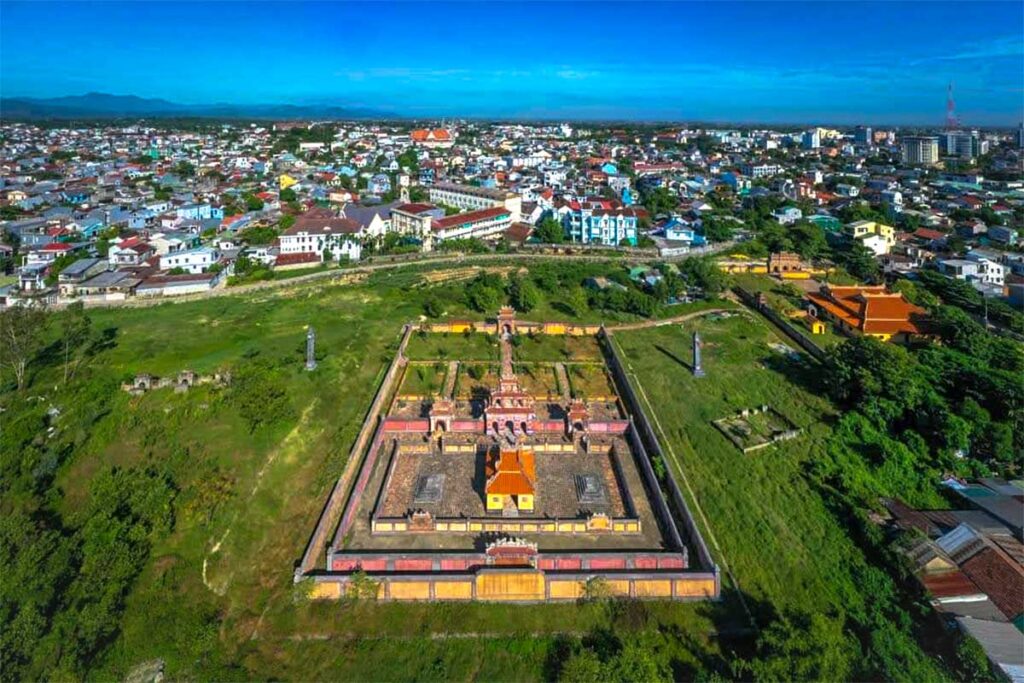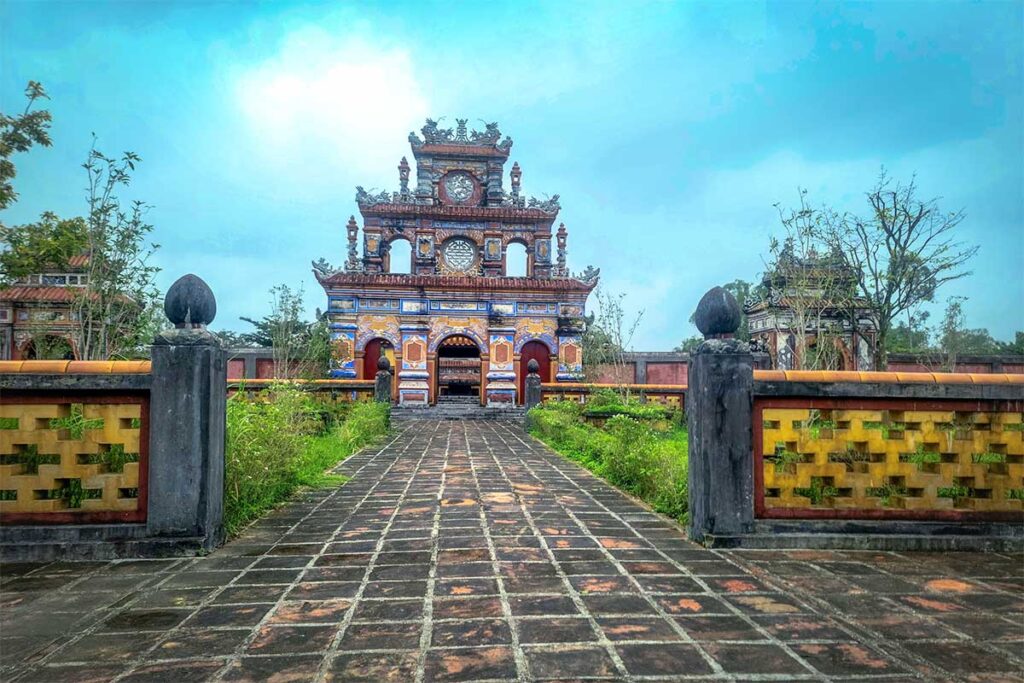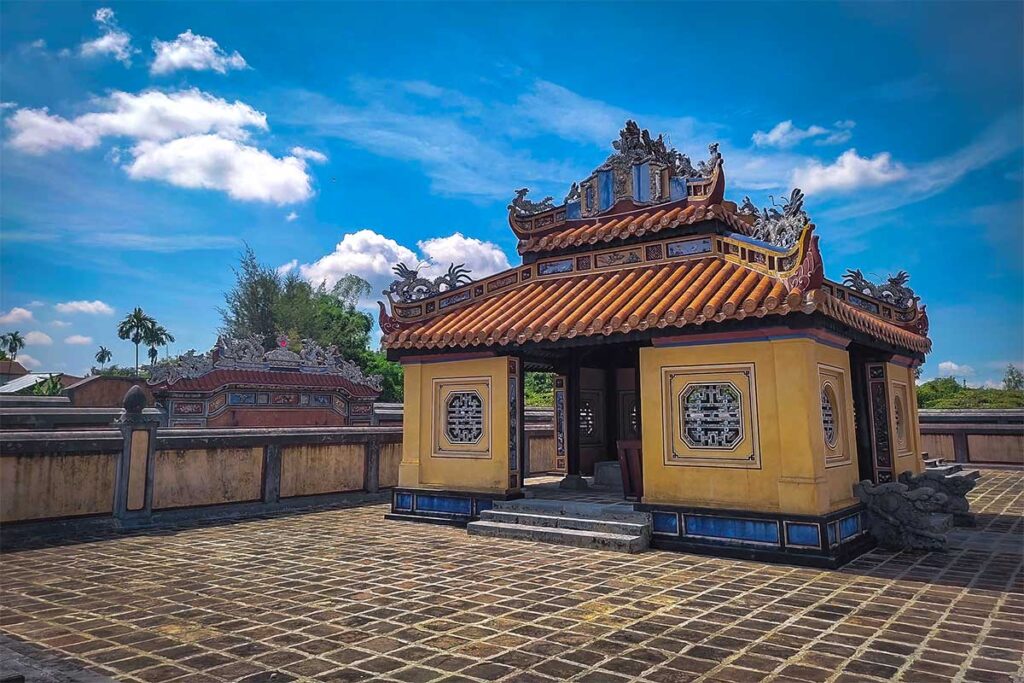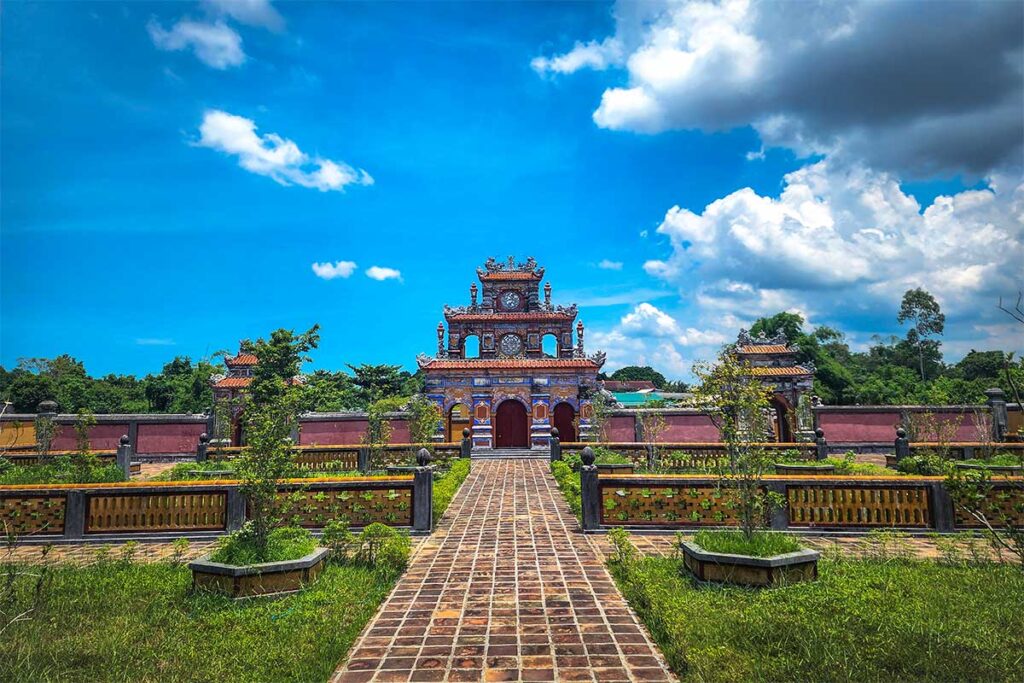What is Duc Duc Tomb?
The Tomb of Duc Duc is a small and rarely visited royal tomb in Hue, tucked away in a quiet residential area west of the Imperial City. It’s the final resting place of Emperor Duc Duc, along with Emperor Thanh Thai and Emperor Duy Tan, making it unique as the burial site of three Nguyen emperors. Many travelers confuse it with the popular Tomb of Tu Duc, but this site is much more modest and unknown—even to some locals. Despite its lack of grandeur, it holds deep historical significance tied to one of the most turbulent chapters of the Nguyen Dynasty.

Who was emperor Duc Duc?
Emperor Duc Duc was the sixth ruler of the Nguyen Dynasty, but his reign was the shortest and perhaps the most tragic. He came to power in 1883 but was deposed after just three days on the throne, following disputes within the royal court. Unlike other emperors who ruled for years or decades, Duc Duc never had the chance to establish his legacy.
After being removed, he was imprisoned and later died under unclear circumstances—most likely in captivity. Despite his brief rule, he became part of a politically unstable period in Vietnamese history, and his death sparked long-lasting tensions within the royal family. His son, Emperor Thanh Thai, and grandson, Emperor Duy Tan, both became emperors later—and both are buried with him at the Tomb of Duc Duc.
History of Duc Duc Tomb
The Tomb of Duc Duc was built under unusual and somber circumstances. After Emperor Duc Duc was deposed and died in prison in 1883, he was initially buried without royal honors. It wasn’t until years later, during the reign of his son Emperor Thanh Thai, that a proper tomb was constructed to recognize his status and give him a dignified resting place.
The tomb is located in An Cuu Ward, not far from the southern edge of Hue’s city center. Unlike the grand royal mausoleums built in remote hills or beside rivers, this one is quietly set within a village area, reflecting both the political tensions surrounding Duc Duc’s death and the modest means of his descendants. Later, his son Thanh Thai and grandson Duy Tan—both of whom also fell out of favor with the French colonial powers—were buried alongside him. The result is a unique shared burial site with a deeply personal and political legacy.
Highlights & architecture
The Tomb of Duc Duc is much smaller and more subdued than the grand royal mausoleums Hue is known for. There are no sweeping staircases, lakes, or dramatic pavilions. Instead, the tomb has a quiet, almost forgotten feel—hidden behind a village gate, with moss-covered walls and simple structures. Still, for those interested in history, its quiet atmosphere and unique story make it worth the stop.
1. Main gate and wall enclosure

The entrance to the tomb is through a plain village street, with a simple stone gate marking the way in. The entire site is surrounded by a low brick wall, which separates it from the surrounding houses. There’s no grandeur here—just a feeling of history tucked away behind everyday life.
2. Burial site of Emperor Duc Duc

At the center is the tomb of Emperor Duc Duc himself. His grave is marked by a modest rectangular stone platform, with a stele and a small path leading to it. It’s a humble site by imperial standards, but powerful when you remember the political struggles that led to his quiet burial.
3. Tomb of Emperor Thanh Thai
To one side stands the tomb of Emperor Thanh Thai, Duc Duc’s son. Thanh Thai was known for resisting French colonial rule and was eventually deposed and exiled. His tomb is slightly more refined, with a stele house and decorative carvings, but still remains small and simple compared to other royal sites.
4. Tomb of Emperor Duy Tan
The third tomb belongs to Emperor Duy Tan, who ruled as a child and later joined anti-French resistance efforts. He died in a plane crash in Central Africa in 1945, and his remains were returned to Vietnam in 1987. His tomb is the most recent addition and stands beside his father and grandfather, forming a rare three-generation royal burial site.
5. Peaceful courtyard and stele pavilion

There’s a small open courtyard where the tombs are arranged, offering space to reflect. A few stele pavilions and altars can be found around the site, but nothing is heavily restored. The worn look of the structures, combined with their historical weight, gives the place an understated power.
Visiting information & Practical tips
Location
The Tomb of Duc Duc is located in An Cuu Ward, just about 2 kilometers southwest of Hue’s city center. Unlike most imperial tombs, it’s not hidden in the hills or forest, but quietly situated in a residential area, making it one of the easiest tombs to reach from the city.
Entrance fee
Entrance ticket: 50,000 VND per person.
Important note: This tomb is not included in the popular combo ticket sold at the Imperial City. That ticket covers major tombs like Tu Duc, Minh Mang, and Khai Dinh, but not the Tomb of Duc Duc—which is often confused with Tu Duc due to the similar name. Tickets must be purchased separately on site.
Opening times
The tomb is open daily from 7:00 AM to 5:30 PM.
Dress code
There’s no strict dress code, but it’s best to dress modestly out of respect for the royal tomb. Light clothing that covers shoulders and knees is recommended, especially when visiting sacred or burial sites.
Guides
You can easily visit the Tomb of Duc Duc on your own, but the site has very little signage or explanation. Hiring a local guide—if you’re combining the visit with other sights—can help provide context about the history and the three emperors buried here.
Nearby sights
This is one of the closest tombs to Hue’s city center, but it’s not located near other royal mausoleums. If you’re already in the area, two other interesting spots nearby are:
- An Dinh Palace – A smaller but ornate palace once used by the Nguyen royal family. Known for its European-style façade and colorful interior murals.
- Phu Cam Cathedral – A striking modernist Catholic church set on a hill, often overlooked but worth a quick visit if you’re in the area.
How to get to Duc Duc Tomb?
Taxi or grab app
The Tomb of Duc Duc is very close to the city center, so getting there by taxi or Grab is quick and easy.
- A one-way taxi ride from central Hue takes about 5–10 minutes and usually costs around 50,000 to 80,000 VND.
- Grab is a convenient option if you have mobile data. You can book a GrabCar or GrabBike (motorbike taxi), and the app shows you the fare in advance.
- Because it’s located in a residential area, it’s best to arrange your return ride in advance or use the app again after your visit.
Cycling or scooter
This tomb is easy to reach by bicycle or scooter, and the short distance from the center makes it a great DIY option.
- By bicycle, it’s a short and flat ride—less than 15 minutes.
- By scooter, you can easily combine it with nearby places like An Dinh Palace or Phu Cam Cathedral.
- There’s limited signage along the way, so using Google Maps is helpful.
Tour
Because the Tomb of Duc Duc is less known and not part of standard tourist routes, most group tours do not include it.
If you’d like to visit with a guide, the best option is to book a private tour, where you can fully customize your itinerary. This allows you to combine Duc Duc Tomb with off-the-beaten-path sights in Hue or include it as part of a more historical, less touristy day trip.
More historical sights in Hue
Besides the Tomb of Duc Duc, Hue is filled with historical landmarks from the time of the Nguyen Dynasty, which ruled Vietnam from 1802 to 1945. The city served as the imperial capital, and today you can still visit tombs, temples, palaces, and monuments that tell the story of Vietnam’s last royal family. If you’re exploring Hue’s heritage, here are a few more must-see places:
- Hue Imperial City – The political and ceremonial center of the Nguyen Dynasty. A large walled complex with palaces, temples, and royal gates, currently under ongoing restoration.
- Minh Mang Tomb – Known for its perfect layout and balance between nature and architecture. It’s one of the most traditional and visually pleasing of all the royal tombs.
- Khai Dinh Tomb – A striking hillside tomb blending Vietnamese and European design. Known for its steep terraces, black stone exterior, and richly decorated mosaic interiors.
- Gia Long Tomb – The most remote of the royal tombs, located in a quiet forested area. Peaceful and rarely visited, it’s the final resting place of the Nguyen Dynasty’s founder.
- Thien Mu Pagoda – Hue’s most iconic religious site, overlooking the Perfume River. The seven-story tower and peaceful riverside setting make it a favorite stop.



